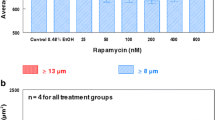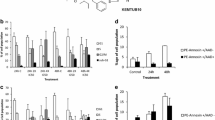Abstract
Taxol is the prototype of a class of antineoplastic drugs that target microtubules. It enhances tubulin-monomer polymerization and stabilizes tubulin polymers, increasing the fraction of cells in the G2 or M phase of the cell cycle. We report that treatment of HL-60 and U937 myeloid cell lines with 1–10 μM taxol induces DNA fragmentation and the appearance of morphological features consistent with the process of apoptosis. Taxol-induced apoptosis is inhibited neither by cycloheximide nor by actinomycin D and therefore appears to be independent of new protein synthesis. Taxol causes arrest in the G2 phase of the cell cycle and affects cell viability but does not induce DNA fragmentation in the K562 erythromyeloid cell line. Protein-synthesis inhibitors, colcemid, ionomycin, and starvation, known to trigger apoptosis, proved ineffective as well. These results suggest that the antineoplastic effect of taxol is mediated in susceptible cell lines by induction of the apoptotic machinery and that K562 partial resistance may depend upon the intrinsic inability of these tumor cells to undergo apoptosis.
Similar content being viewed by others
Abbreviations
- CHX:
-
cycloheximide
- Act D:
-
actinomycin D
- PI:
-
propidium iodide
References
Barry MA, Behnke CA, Eastman A (1990) Activation of programmed cell death (apoptosis) by cisplatin, other anticancer drugs, toxins and hyperthermia. Biochem Pharmacol 40: 2353
Bertrand R, Solary E, Jenkins J, Pommier Y (1993) Apoptosis and its modulation in human promyelocytic HL-60 cells treated with DNA topoisomerase I and II inhibitors. Exp Cell Res 207: 388
Bhalla K, Ibrado AM, Tourkina E, Tang C, Mahoney ME, Huang Y (1993) Taxol induces internucleosomal DNA fragmentation associated with programmed cell death in human myeloid leukemia cells. Leukemia 7: 563
Christiaansen JE, Sears DW (1985) Lack of lymphocyte-induced DNA fragmentation in human targets during lysis represents a species-specific difference between human and murine cells. Proc Natl Acad Sci USA 82: 4482
Clarke AR, Purdie CA, Harrison DJ, Morris RG, Bird CC, Hooper ML, Wyllie AH (1993) Thymocyte apoptosis induced by p53-dependent and-independent pathways. Nature 362: 849
Cohen GM, Sun XM, Snowden RT, Dinsdale D, Skilleter DN, (1992) Key morphological features of apoptosis may occur in the absence of internucleosomal DNA fragmentation. Biochem J 286: 331
Crossin KL, Carney DH (1981) Evidence that microtubule depolymerization early in the cell cycle is sufficient to initiate DNA synthesis. Cell 23: 61
Diomede L, Colotta F, Piovani B, Re F, Modest EJ, Salmona M (1993) Induction of apoptosis in human leukemic cells by the ether lipid 1-octadecyl-2-methyl-rac-glycero-3-phosphocholine. A possible basis for its selective action. Int J Cancer 53: 124
Hei TK, Hall EJ (1993) Taxol, radiation and oncogenic transformation. Cancer Res 53: 1368
Hickman JA (1992) Apoptosis induced by anticancer drugs. Cancer Metastasis Rev 11: 121
Holmes FA, Frye D, Theriault RL, Walters RS, Forman AD, Newton LK, Buzdar AU, Hortobagyi GN (1991) Phase II study of taxol in patients with metastatic breast cancer. Proc Am Soc Clin Oncol 10: 60
Legha SS, Ring S, Papadopoulos N, Raber M, Benjamin RA (1990) Phase II study of taxol in metastatic melanoma. Cancer 65: 2478
Martin SJ, Cotter TG (1990) Disruption of microtubules induces an endogenous suicide pathway in human leukemia HL-60 cells. Cell Tissue Kinet 23: 545
Martin SJ, Lennon SV, Bonham AM, Cotter TG (1990) Induction of apoptosis (programmed cell death) in human leukemic HL-60 cells by inhibition of RNA or protein synthesis. J Immunol 145: 1859
McGahon A, Bisonnette R, Schmitt M, Cotter KM, Green DR, Cotter TG (1994) BCR-ABL maintains resistance of chronic myelogenous leukemia cells to apoptoic cell death. Blood 83: 1179
McGuire WP, Rowinsky EK, Rosenshein NB, Grumbine RC, Ettinger DS, Armstrong DK, Donehover RC (1989) Taxol: a unique antineoplastic agent with significant activity in advanced ovarian epithelial neoplasms. Ann Intern Med 111: 273
Nicolaou KC, Riemer C, Kerr MA, Rideout D, Wrasidio W (1993) Design, synthesis and biological activity of protaxols. Nature 364: 464
Nicoletti I, Migliorati G, Pagliacci MC, Grignani F, Riccardi C (1991) A rapid and simple method for measuring thymocyte apoptosis by propidium iodide staining and flow cytometry. J Immunol Methods 139: 271
Oberhammer F, Wilson JW, Dive C, Morris ID, Hickman JA, Wakeling AE, Walker PR, Sikorska M (1993) Apoptotic death in epithelial cells: cleavage of DNA to 300 and/or 50 kb fragments prior to or in the absence of internucleosomal fragmentation. EMBO J 12: 3679
Owens GP, Hahn WE, Cohen JJ (1991) Identification of mRNAs associated with programmed cell death in immature thymocytes. Mol Cell Biol 11: 4177
Roberts JR, Allison DC, Donehover RC, Rowinsky EK (1990) Development of polyploidization in taxol-resistant human leukemia cells in vitro. Cancer Res 50: 710
Rowinsky EK, Donehover RC, Jones RJ, Tucker RW (1988) Microtubule changes and cytotoxicity in leukemic cell lines treated with taxol. Cancer Res 48: 4093
Rowinsky EK, Cazenave LA, Donehover RC (1990) Taxol: a novel investigational antimicrotubule agent. J Natl Cancer Inst 82: 1247
Rowinsky EK, Onetto N, Canetta RM, Arbuck SG (1992) Taxol: the first of the taxanes, an important new class of antitumor agents. Semin Oncol 19: 646
Schiff PB, Fant J, Horwitz SB (1979) Promotion of microtubule assembly in vitro by taxol. Nature 277: 665
Wani MC, Taylor HL, Wall ME, Coggon P, McPhall AT (1971) Plant antitumor agents. VI. The isolation and structure of taxol, a novel antileukemic and antitumor agent fromTaxus brevifolia. J Am Chem Soc 93: 2323
Wyllic AH (1992) Apoptosis and the regulation of cell numbers in normal and neoplastic tissues: an overview. Cancer Metastasis Rev 11: 95
Wyllie AH (1993) Apoptosis (The 1992 Frank Rose Memorial Lecture). Br J Cancer 67: 205
Zakeri ZF, Quaglino D, Latham T, Lockshin RA (1993) Delayed internucleosomal DNA fragmentation in programmed cell death. FASEB J 7: 470
Author information
Authors and Affiliations
Rights and permissions
About this article
Cite this article
Gangemi, R.M.R., Tiso, M., Marchetti, C. et al. Taxol cytotoxicity on human leukemia cell lines is a function of their susceptibility to programmed cell death. Cancer Chemother. Pharmacol. 36, 385–392 (1995). https://doi.org/10.1007/BF00686187
Received:
Accepted:
Issue Date:
DOI: https://doi.org/10.1007/BF00686187




